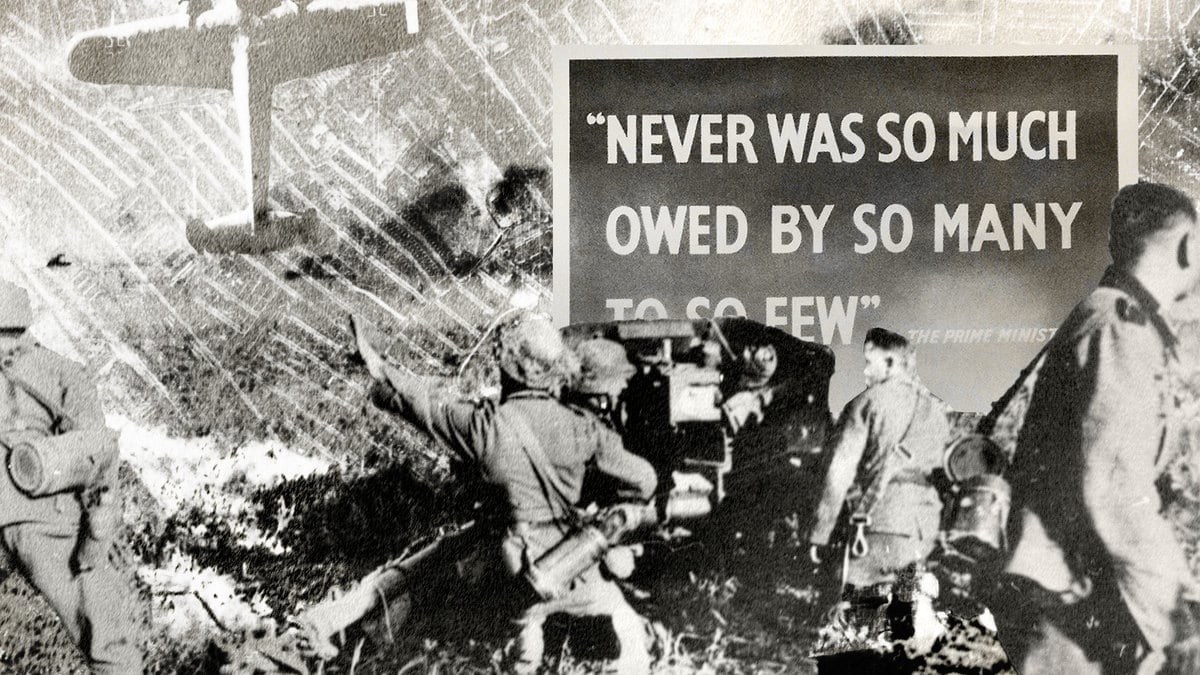No doubt about it: World War II was by far the single most significant event in shaping the world in which we live today. This mammoth conflict brought about the demise of the European empires, a yearning for independence among the colonized peoples of Asia, the Middle East, and Africa. It catapulted the United States into a position of world leadership it still holds, however tenuously. The Second World War led ineluctably to the great struggle of the last half of the 20th century, the Cold War, from which the United States and the West emerged victorious.
Among its myriad ramifications, World War II dramatically reinforced America’s longstanding opinion of itself as a chosen nation, a “city upon a hill” with a special mission to expand the boundaries of human freedom, both at home and abroad. A fascinating and subtle recently published book, Looking for the Good War: American Amnesia and the Pursuit of Happiness, by West Point literature professor Elizabeth D. Samet, argues that the popular understanding of America’s role in the conflict is deeply encrusted with unexamined myths and wishful thinking. In short, it is not real history. The “heroic” interpretation of the war as a “Great Crusade of liberty,” in which a unified and altruistic American populace rose up to meet the menacing challenge of fascism and totalitarianism, and saved the world from moral as well as political abyss, obscures more than it illuminates, and strips the most destructive event of human history of its defining characteristics: complexity, ambiguity, and the abandonment of many of the limitations nations has placed on the conduct of war, with a view to limiting its destructiveness.
What’s more, says Samet, this mythic, self-congratulatory reading of the American experience of the conflict has proven dangerous. It has had a profound effect on the mindset of America’s foreign policy establishment for more than seventy years, too often providing a bogus rationale for military adventurism aimed at changing the social and political landscape of places like Vietnam, Afghanistan, and Iraq.
The sanitized and sentimental view of the United States in World War II reached its apotheosis in the 1990s but remains alive and well today. Leading the charge thirty years ago was the celebrated historian Stephen Ambrose, along with NBC news anchor Tom Brokaw, and of course, Steven Spielberg, the filmmaker behind Saving Private Ryan and the miniseries Band of Brothers. Ambrose, who began his career as a serious academic historian and a biographer of Eisenhower, published several blockbuster bestsellers during the decade, including Band of Brothers and D-Day: June 6, 1944, among other books. These tomes feature fast-paced, action-oriented narratives focused tightly on celebrating the exploits and virtues of the ordinary American fighting man in Western Europe.
Ambrose once said that when he was ten, he looked up to the GIs returning from Europe as “giants who saved the world from barbarism.” That view of his subjects quite obviously prevailed in Ambrose’s imagination well into mature adulthood, shaping the structure and tone of his narratives far more than his demonstrable skills as a practitioner of serious historical analysis. But the real war, to paraphrase what Walt Whitman once said about the Civil War, doesn’t make it into his books.
Ambrose’s World War II histories and Brokaw’s celebrated The Greatest Generation volume, says Professor Samet, share “a worshipful tone and largely ignore contradictions and complexity that prove disruptive to a sentimental account of American decency and goodness.” The core tenets of their myth-heavy narratives are spelled out with both clarity and economy by Samet in the beginning of her book:
1. The United States went to war to liberate the world from tyranny.
2. All Americans were absolutely united in their commitment to the war effort.
3. Everyone on the home front made tremendous sacrifices.
4. Americans are liberators who fight decently, reluctantly, only when they have no choice.
5. World War II was a foreign tragedy with a happy American ending.
6. Everyone has agreed on points 1-5.
Without for a moment denying the necessity of the war or the moral legitimacy of the Allies’ objective, Samet demolishes the authority of the celebratory narratives of Ambrose, Brokaw, Spielberg, and their more obscure acolytes by unpacking the experiences and reflections of American combat veterans, serious historians, and filmmakers who have delved into the war’s more complicated and troubling aspects. Through her deft exploration, we come to see, among other things, that that the American people were anything but united behind going to war until Pearl Harbor, and even then, the commitment to fighting in Europe was not universally acknowledged by any stretch of the imagination. For most GIs, ideology–the commitment to stamp out fascism and militarism–was not at all a big motivator. On the home front, a great number of ordinary Americans made little or no sacrifices, while hundreds of thousands of others profited by operating on the black market. America’s airborne “liberators” dropped firebombs on German and Japanese cities, with a view to burning to death civilians as well as militarily valuable targets. Although Roosevelt and the American high command knew very well that Jews were being gassed and incinerated in death camps, liberating those horror chambers was never a high priority.
Perhaps the most inconvenient truth for those who prefer to see the United States as the Savior of the World in 1945 is this sobering fact: the Western Front in World War II spearheaded by the Americans and the British from June 6, 1944 until the end of the conflict the following May was a decidedly secondary front. The “main effort,” to use the term of military planners, was in the East, where the Soviets and their allies waged a titanic struggle against the Nazis. The Soviet Union lost more than 30 million people as a result of the conflict, including 10 million Red Army soldiers. The United States lost 405,000. Stalin was a master liar, but he told the hard truth when he said after the war that “England provided the time, the Americans provided the money, and the Russians provided the blood.”
The celebratory narrative of America in World War II, says Samet, appeals to our national vanity, and “remains a bulwark against doubt and disillusion, a golden age to which we can always retreat.” Yet this retreat, as Samet along with many other serious students of recent American military history knows, has certain malign implications. “Every American exercise of military force since World War II, in the eyes of its architects, has inherited that war’s moral justification and been understood as its offspring: motivated by its memory, prosecuted in its shadow, inevitably measured against it.”
Among the many books Samet commends as an anecdote to the sentimentality and self-satisfied histories of Ambrose and Brokaw is Studs Terkel’s The Good War, an oral history of the conflict. The book stands out for offering a much more nuanced and realistic portrait of what the “Big One” was all about. In The Good War, retired Rear Admiral Gene La Roque, who served as a junior officer in the World War II and a senior one in Vietnam, reports that the “twisted memory” of the Second World War “encouraged men of my generation to be willing, almost eager, to use military force in the world.” Unfortunately, the “twisted memory” continued to fuel foolhardy military adventures well after the World War II generation faded away.
Of course, scores of books have been published that present a more complicated and realistic view of the horrific violence and savagery that characterized the War. One might well start with Rick Atkinson’s masterful “Liberation Trilogy “narratives of the European theater, or Ronald Spector’s Eagle against the Sun, a superb one-volume history of the Pacific War. For a searing and heartbreakingly human account of one enlisted Marine’s experience fighting on the Pacific islands, see E.B. Sledge’s With the Old Breed on Peleliu and Okinawa. The great British military historian John Keegan called Sledge’s book “the best memoir to come out of the Pacific War.”
Samet’s fine book, for all its merits, is not the first to explore this broad theme deftly. More than thirty years ago, the literary historian Paul Fussell explored similarly disturbing themes in Wartime: Understanding and Behavior in World War II. Fussell’s irony-laced, sardonic account exposes the monstrosity that is mass-production, industrial war as he saw it up close and personal as an infantry lieutenant commanding a U.S. Army platoon in Western Europe. So much of the wanton destruction and unnecessary violent death during American operations, says Fussell, can be put down to the rank amateurism of America’s conscript army, as well as the incompetence and venality of glory-seeking officers. Plain old bad luck seemed to dog commanders’ strategies and plans at every turn. Based on Fussell’s grim accounts of U.S operations in both Europe and the Pacific, it seems a sure bet that more Americans were killed as a result of incompetence and friendly fire incidents in the Second World War than have died in Afghanistan and Iraq combined.
Fussell has no patience at all for the adventure story accounts of glory and derring-do put forward by popular historians of the war. Like Samet and La Roque, Fussell sees the traditional celebratory narrative of America’s World War II as not only bad history, but dangerous. Such books as Robert Leckie’s Delivered from Evil: The Saga of World War II—a 1987 book that anticipates the World War II “Greatest Generation” craze of the 1990s led by Ambrose—“like to ascribe clear, and usually noble, cause and purpose to accidental or demeaning events. Such histories thus convey to the optimistic and credulous a satisfying, orderly, and even optimistic and wholesome view of catastrophic occurrences—a fine way to encourage a moralistic, nationalistic, and bellicose politics.”
In the end, Samet joins Fussell in urging Americans to experience the discomfort that comes from looking at America’s actual experience in the most destructive war in history, warts and all, for a simple reason. It’s real.








